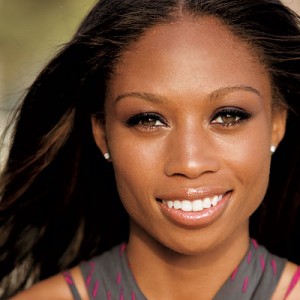Tips For Improving Your Sports Performance: Take Your Vision Beyond 20/20

World-Champion Sprinter, Allyson Felix
Until recently, I hadn’t given much thought to what it actually means to have 20/20 vision. Like most people, I assumed that 20/20 vision was just a synonym for “perfect” eyesight. But when I recently spoke with optometrist Graham Erickson, a sports vision specialist, I realized that there is an entire medical field devoted to optimizing vision for athletes – so that they can see better than 20/20, perhaps even 20/8! In fact, 20/20 vision just means that you can see an object 20 feet away as well as the “average” person.
In my interview with Dr. Erickson, I learned that some professional baseball players have vision that is two times better than average, allowing them to judge pitches further away by seeing how the baseball’s stitches and seams turn in mid-air. This kind of vision is not necessarily something that you’re born with – it can come with training and good vision-correcting lenses. There are exercises that professional do to improve their contrast sensitivity, peripheral visual acuity, and reaction times. And we regular folks (weekend warriors, kids, and aspiring athletes) can also “pump up our peepers” with exercises that we can do at home. Please listen in to the full Healthy Vision segment to find out how to do these exercises:
I also learned that different athletes (such as basketball players, archers, and offensive linemen) have unique visual demands, and they train for those demands quite differently. While a basketball player may focus on improving his “court vision” (dividing his attention between guarding “his man” and being aware of what’s going on in the periphery), an archer may rely almost exclusively on her central vision,
while an offensive lineman may need to split his attention between central near vision (controlling his man) and peripheral vision to pick up shifts by the defense. Since it’s estimated that 80% of the information we take in (while playing sports) comes from our eyes, even slightly blurry vision can dramatically affect performance.
Even though there is a lot that athletes can do to improve their visual skills, very few competitive athletes get annual comprehensive eye exams. In my latest Healthy Vision episode, NBA star Tyreke Evans* offered a call-to-action to his peers regarding regular check ups, and World-Champion female sprinter Allyson Felix spoke to me about the role that good vision has had in her success.

Sacramento Kings' Tyreke Evans
In summary, I learned from Dr. Erickson and Allyson Felix, that eye fitness is a critical part of competitive sports, but unfortunately something we often don’t think about. There are new training programs that help to develop peripheral vision skills that may reduce the risk of being blind sided in football or hockey games, and can therefore reduce concussion risk. Athletes should seek out an eye care professional who specializes in sports vision in order to optimize their visual potential. The American Optometric Association’s Sports Vision Section offers a doctor locator to help patients find sports vision experts in their area. Please check out the website here (or their Facebook page) for more information.
*You can find out more about Tyreke Evans and the importance of eye exams at facebook.com/vspvisioncare.
-Val Jones, M.D. is a paid consultant for Johnson & Johnson Vision Care, Inc.-










